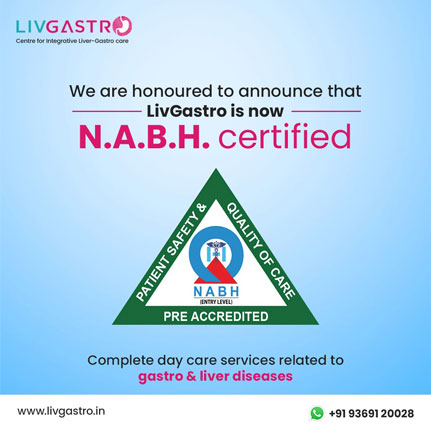
Team LivGastro provides utility based model of care that integrates specialists, primary care , laboratory, imaging and other health services to give patients a convenient and superior outcome along with a pleasant experience. Since we primarily focus on outdoor-patient care, on the site instant testing along with detailed and accurate results, we enable our patients and their families save
a lot of effort, time and money.

Upper GI endoscopy is a medical procedure in which a gastroenterologist uses a 100 cm long flexible tube with a camera attached at the tip, called endoscope — to see the inner part of the upper digestive system.
Most of the time it is performed without sedation but for anxious or uncooperative patient it is done in light sedation. It is also called as EGD or esophagogastroduodenoscopy.
Upper GI endoscopy is also indicated in abnormal lab test report like…
A great advantage of ugi endoscopy is that doctor can take biopsy by passing an instrument through the endoscope to obtain a small piece of tissue. Biopsies are required for the accurate diagnosis of cancer, celiac disease
or gluten sensitive enteropathy, various types of gastritis, hpylori or whippel’s disease or agamaglobulinemia.
Upper GI endoscopy is also used to stop bleeding from peptic ulcer disease, varices or GAVE. It can be used to dilate the stricture related to corrosive injury or peptic ulcer or malignancy. It is also used for removing foreign
body like pins dentures, coin battery form upper GI tract and hence surgery can be avoided.
Inner lining of your upper GI tract during is examined by endoscopy. Therefore to clearly visualize the digestive system it is advised not to eat, drink, smoke, during the 6 hours before the procedure.
A doctor performs an upper GI endoscopy. An intravenous (IV) needle will be placed in the arm to provide an injection for sedation. In some cases, the procedure can be performed without sedation. You will be given a spray anesthetic
on the back of your throat. This will numb the throat and prevent the gag reflex or discomfort due to endoscopy.
Patient lie on one side on an examination table. The gastroenterologist gently feed the endoscope down the food pipe and then into your stomach and duodenum. The camera which is mounted on the tip of endoscope will send a video
image to a monitor, allowing close examination of the lining of your upper GI tract. During the upper GI endoscopy, the doctor may…
The procedure most often takes 2-3 minutes. Post procedure patient can perform all the normal activities. Few patients experience bloating or nausea for a short time, a sore throat for 1 to 2 days.
Upper GI endoscopy is safest procedure in gastroenterology. Complications like perforation, bleeding, sedation related cardiac or respiratory problems are very rare after endoscopy. The risks of an upper GI endoscopy include…
